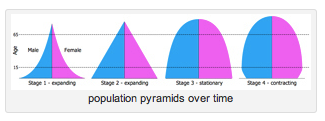The first American baby boomers turn 65 this year, marking the start of a geezer boom that will see as many as 10,000 erstwhile hippies qualifying for senior discounts every day for the next 18 years (globally, the stat tops 125,000 per day). As all things baby boom, it is a marketer’s dream, complete with an MIT lab devoted to designing products and services to help seniors “‘do things’ throughout the lifespan,” and anti-aging hucksters lining up for a piece of a multi-billion dollar pie.
The bigger story, though, is about demographic distribution, visualized in “population pyramids.”
When a population is young, the graph looks like a pyramid, with children at the bottom far outnumbering their elders. Epidemics, wars and natural disasters chip chip away at a pyramid’s profile, but nothing chips more dramatically than contraception. It is no coincidence that the US baby boom ended a few years after “The Pill” was approved by the FDA in the early 1960s. Contraception has also played a key role battling skyrocketing birth rates in developing countries, with collateral benefits for women’s rights and economic improvement.
Journalist Ted Fishman’s new book, “Shock of Gray: The Aging of the World’s Population and How it Pits Young Against Old, Child Against Parent, Worker Against Boss, Company Against Rival, and Nation Against Nation, goes into great jaw-dropping detail about those consequences, noting that two other 21st trends—urbanization and globalization—are actually making things worse.
“A Shock of Gray” is a guide book to a world that’s coming. We are just in the first ten minutes of a demographic denouement that’s been unfolding for 100,000 years. For the first time in history, there are more people over 50 than there are under 17. And that turns the world upside down.
Globally, the median age is 28, meaning there are just as many people older than that as younger. In less than a decade, there will be more people over 65 than under the age of 5. By 2045, there will be more people over 60 than children, period.
Interestingly, 2045 is also the year futurist Ray Kurzweil predicts for the “Singularity,”the moment when machine intelligence and technological know-how matches, then surpasses, human capabilities, leading to a “transhuman” future unbounded old fashioned slow-and-steady evolutionary constraints.
he most important perspective in my view is that health, medicine, and biology is now an information technology, whereas it used to be hit or miss. We not only have the (outdated) software that biology runs on (our genome), but we have the means of changing that software (our genes) in a mature individual with such technologies as RNA interference and new forms of gene therapy that do not trigger the immune system. (from Technology Review)
Humans are turning into Energizer bunnies that just keep going, though sadly not without operational glitches.
The rates of age-related chronic illnesses—diabetes (exacerbated by an obesity epidemic), cancer, impaired vision and dementias—are spiking upwards with no end in sight. Beyond the incalculable heartbreak, the economics are staggering. According to a new study released by Alzheimer’s Disease International, “the worldwide costs of dementia will exceed 1% of global GDP in 2010, at US$604 billion.”
Even diseases that don’t affect the elderly directly can have a tremendous impact on them. Pandemic influenza, for example, usually takes its biggest toll on adults in the prime-of-life. But since those people are also the caregivers, their loss can easily cascade into another round of tragedy.
Although the problem is one of demographic relativity—the ratio of old to young—the answer is not more babies. The absolute population numbers are still rising—expected to hit 9 billion by mid-century—while limited natural resources are either under siege or running low and food production barely keeps pace with demand.
Kurzweil, ever the optimist, is hopeful that the Singularity will also deliver a bounty of tech solutions for all manner of catastrophic developments.
Meanwhile, the fuse has been lit on a population bomb—albeit an evil twin of the one Ehlich warned about—and the clock is ticking.
“How terribly strange to be 70,” sang Old Friends Simon & Garfunkel in 1968 at the ripe age of 27. This year, they will be 70. Maybe not so strange any more?
- “The Cost of the World’s Long Senior Moment” / Council on Foreign Relations
- and more!










